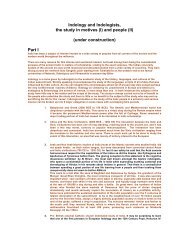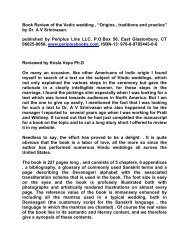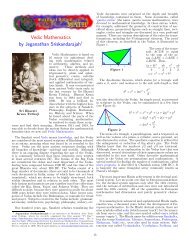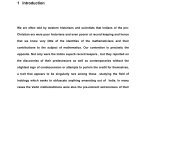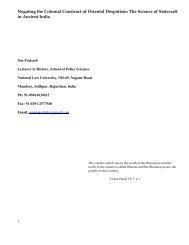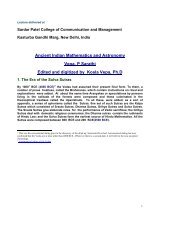The Dhaarmik Traditions - Indic Studies Foundation
The Dhaarmik Traditions - Indic Studies Foundation
The Dhaarmik Traditions - Indic Studies Foundation
Create successful ePaper yourself
Turn your PDF publications into a flip-book with our unique Google optimized e-Paper software.
general rule of thumb one elects to be in a profession which utilizes his GuNAs<br />
fully. For example Brahmanas tend to cluster around intellectual pursuits (teaching,<br />
legal, corporate management, administration etc. In the past the choice of<br />
professions available to Brahmanas were limited to priestly duties and the services<br />
he could render as a Minister to the Maharaja including mundane tasks such as<br />
accounting and cooking. In recent years substantial numbers of Brahmanas faced<br />
with increasing discrimination from their own government have elected to go into<br />
Business, so that his varna is that of a Vaisya, unless he maintains his competency<br />
and knowledge of the Vedic scripture and adheres to the injunctions of a Brahmana<br />
Since there are three guNAs, why are there four varNAs<br />
<strong>The</strong> GuNa Varna Vyavastha arose out of the propensity of individuals to exhibit a<br />
dominant GuNa or GuNAs, rather than an equal distribution of all three. If all<br />
individuals had only one guNa in them, then it would be logical to conclude that there<br />
can be only 3 varNAs. But this is not so. <strong>The</strong> mapping between GuNAs and Varna is<br />
not one to one .<strong>The</strong>se 3 guNAs are found in 'varying degrees' in all individuals, be they<br />
Indian, American or British. So the ancient seers made a broader classification of the<br />
individuals based on the guNAs present in them. See the exposition by Sri Krishna in<br />
Chapter 18, verses 18-40, on the GuNAs that the various Varnas should exhibit in order<br />
to qualify as a member of a particular Varna. Note that it is not the case that the<br />
Brahmanas and Kshatriyas are not subsets of the other two. Each Varna possesses a<br />
mix of GuNAs which while not being mutually exclusive, and while having a degree of<br />
overlap, have distinctive characteristics as is to be expected if it was a division of<br />
labor which we emphatically believe to be the case<br />
166



